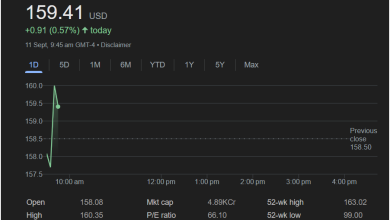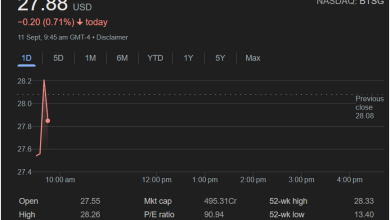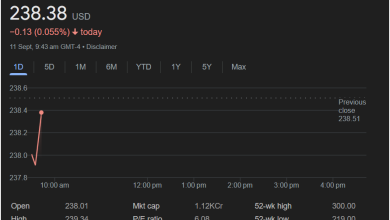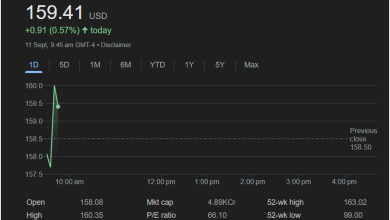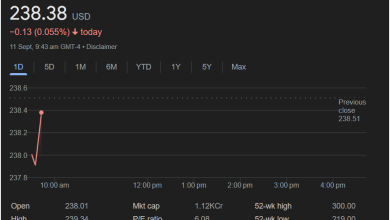IBM Stock Shows Steady Strength with 1.13% Gain as Investors Weigh AI Promise Against Valuation
The technology icon closed at $242.09, demonstrating solid investor support. While its high P/E ratio signals strong growth expectations, the attractive 2.78% dividend yield provides a compelling case for income-focused portfolios

Published: August 23, 2025
(ARMONK, NY) – International Business Machines Corp. (NYSE: IBM) registered a solid performance in the stock market during yesterday’s trading session, closing the day with a respectable gain of 1.13%. The legacy tech giant’s shares ended the session on August 22nd at
2.71 and reflecting a quietly confident mood among investors.
The day’s trading was characterized by an initial burst of enthusiasm that saw the stock gap up at the open, followed by a period of healthy consolidation. This steady, rather than speculative, rise suggests a considered belief in the company’s ongoing transformation into a hybrid cloud and artificial intelligence powerhouse. The positive momentum also carried into after-hours trading, where the stock added another $0.29, or 0.12%, to reach $242.38.
While the single-day gain may not be as dramatic as those seen in more volatile tech names, it contributes to a narrative of resilience for “Big Blue.” The stock’s current position, well above its 52-week low but also significantly shy of its high, places it at a fascinating crossroads. Investors are actively weighing its promising future in AI against a valuation that already demands substantial growth.
This in-depth article will break down the specifics of the August 22nd trading session, analyze the key financial metrics that define IBM’s current investment profile, and explore the broader strategic initiatives that are shaping its path forward.
Part 1: A Dissection of the Day’s Trading Activity
IBM’s stock performance yesterday told a story of early conviction followed by stable price action, a pattern often favored by institutional investors.
-
A Strong Open: The stock began trading at $240.74, noticeably higher than the previous day’s close of $239.38. This immediate upward move indicated that buying interest had built up overnight.
-
Morning Peak: The bullish sentiment propelled the stock to its intraday high of $243.68 within the first couple of hours of trading. This peak represented the most optimistic point of the day as early buyers pushed the price upward.
-
Finding a Floor: The day’s low was recorded at $240.22, just below the opening price. The fact that the stock did not re-test the previous day’s close demonstrates underlying support and a reluctance from sellers to let the price drop.
-
Afternoon Consolidation: As seen in the intraday chart, after reaching its peak, the stock’s price oscillated in a relatively tight range throughout the afternoon. It gave back some of its initial gains but ultimately held its ground, closing strong at $242.09. This pattern suggests that after the initial rally, the stock found a new, stable level of equilibrium where buyers and sellers were well-matched.
The day’s trading volume and price action signal a market that is comfortable holding IBM at these levels, willing to reward the company’s progress while waiting for further catalysts to drive the next major move.
Part 2: The Driving Forces – Why is IBM Gaining Traction?
A 1.13% move in a mega-cap stock like IBM is typically driven by a combination of broad market trends and company-specific sentiment.
-
The AI and Hybrid Cloud Narrative: The primary driver of optimism surrounding IBM is its strategic pivot to high-growth sectors. The company has staked its future on two main pillars:
-
Artificial Intelligence: With its Watsonx platform, IBM is targeting the lucrative enterprise AI market. Unlike consumer-facing AI, Watsonx is designed to help large corporations build, train, and deploy their own AI models securely using their own data. This focus on data privacy and governance is a key differentiator that resonates strongly with blue-chip clients. Every positive development in the AI space tends to lift sentiment for key players like IBM.
-
Hybrid Cloud: Leveraging its landmark acquisition of Red Hat, IBM has become a leader in the hybrid cloud space. This strategy acknowledges that most large enterprises will not move all their data to a single public cloud but will instead use a mix of on-premise servers and multiple public clouds. IBM’s software and consulting services are crucial for managing this complex environment.
-
-
Defensive Appeal and a Powerful Dividend: In a market that can be prone to volatility, IBM offers attributes of a more defensive investment. The most prominent of these is its substantial dividend. With a dividend yield of 2.78% and a quarterly payout of $1.68 per share, IBM is a cornerstone for many income-oriented investment portfolios. This reliable return provides a cushion for investors and attracts capital that might otherwise avoid the more speculative parts of the tech sector.
-
Positive Sector Momentum: The technology sector as a whole may have experienced a positive day, creating a rising tide that lifted major players, including IBM. Positive economic news or a favorable outlook from another tech bellwether can often have a ripple effect across the industry.
Part 3: Understanding the Valuation – A Tale of Two Metrics
The provided data reveals a fascinating duality in how the market values IBM, making it a subject of debate between growth and value investors.
-
The High P/E Ratio (39.27): The Price-to-Earnings ratio of 39.27 is relatively high for a company of IBM’s age and size. A high P/E indicates that investors are willing to pay a premium for the stock based on high expectations for future earnings growth. This valuation is a clear vote of confidence in IBM’s AI and cloud strategy. It suggests the market believes the company’s transformation will accelerate revenue and profit growth significantly in the coming years. However, it also introduces risk; if IBM fails to deliver on this expected growth, the stock could be vulnerable to a correction.
-
The Attractive Dividend Yield (2.78%): In contrast to its growth-oriented P/E ratio, the dividend yield of 2.78% is characteristic of a mature, stable, value-oriented company. This yield is significantly higher than that of many other large-cap tech companies and even surpasses the yield on some government bonds. This makes IBM a hybrid investment: a stock that offers the potential for high-tech growth while simultaneously providing a robust income stream typically associated with more conservative investments.
The 52-Week Context: A Work in Progress
The stock’s 52-week range, from a low of
296.16, provides crucial context. At its current price of $242.09, IBM has made a substantial recovery from its lows, rewarding investors who bought in during weaker periods. However, it remains approximately 18% below its 52-week high. This indicates that while optimism has returned, there is still some skepticism or a “wait-and-see” approach from the market. To breach its prior highs, IBM will need to consistently demonstrate tangible results from its strategic initiatives, likely in the form of accelerating revenue growth in its upcoming quarterly reports.
Part 4: The Strategic Horizon – What’s Next for Big Blue?
Looking ahead, IBM’s trajectory will be defined by its execution in key innovative areas.
-
Enterprise AI Adoption: The central question is how quickly IBM can translate interest in its Watsonx platform into widespread, large-scale contracts. Success here will be the primary catalyst for justifying its high P/E ratio.
-
Consulting and Software Synergy: The company’s massive consulting arm is a key advantage. By bundling its AI and hybrid cloud software with its implementation and advisory services, IBM can offer an end-to-end solution that competitors may struggle to match.
-
Quantum Computing Leadership: While not a near-term revenue driver, IBM remains a global leader in the race to build a commercially viable quantum computer. Any significant breakthrough in this field could provide a massive long-term boost to the stock’s value and prestige.IBM’s solid showing on August 22nd is a microcosm of its broader story: a company in a state of successful, but still incomplete, transformation. The day’s gain reflects an acknowledgment of its progress and strategic positioning. For investors, IBM presents a unique proposition—a blend of high-growth potential powered by AI and a foundation of stability provided by its formidable dividend. The path to reclaiming its 52-week high will depend on its ability to turn its technological promise into undeniable financial performance.
